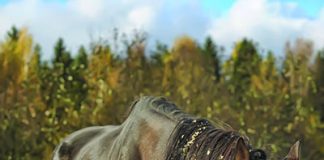
Q: I know I’m supposed to cool my horse down completely after every ride. What’s the best way to determine if she’s properly cooled off?

A: You sound like a knowledgeable and conscientious rider! No doubt you have your own copy of Dr. Hilary Clayton’s Conditioning Sport Horses, which has a great chapter on this topic, Chapter 11: The Daily Workout.
| “Regardless of the type of exercise that will be performed, the daily workout starts with a warm up, progresses to the schooling or conditioning exercises, and ends with an active warm down followed by a cooling out period.” |
Your question asked specifically about cooling off, but I wanted to take this opportunity to remind everyone about the importance of a warm UP as well as a warm DOWN. The goal is to either gradually increase the exercise intensity to help the horse’s body adjust from rest to work or gradually decrease the exercise intensity to help the horse’s body adjust from work to rest. Either way, you’re making a progressive change in work demands and not starting or stopping abruptly.
Even in winter, exercise generates heat, increases the heart rate and respiratory rate, and allocates more blood to the muscles so it is important to reverse this process by allowing the body to cool down, slow the heart rate and respiratory rate, and redistribute the blood back to the rest of the body. By the way, that’s how you know your horse is properly cooled off, when her vitals have returned to normal.
Notice that I bring up a season (winter). That’s because the warm down and cooling out processes are probably going to be different based on the temperature where you live. Since the objective is to be able to return your horse to her stall, paddock, or pasture both dry and at her normal body temperature, heart rate, and respiratory rate, sometimes you may find very little cooling out is necessary while other times more effort may need to be spent in this phase.
Here are some examples:
- Suppose it’s 90 degrees with 80% humidity. You ride early in the morning and in the shade, but your mare is still blowing and sweating when you’re done. In this scenario, you might need to walk, apply cold water, and scrape until her pulse, breathing and temperature return to normal.
- Now imagine it’s 40 degrees and you had a vigorous lesson with your trainer that left you and your horse both sweating and panting. You wouldn’t apply cold water, but you might throw on a cooler and handwalk until she’s dry.
- In the final scenario, say it’s 20 degrees and you decided it was too cold to do more than check in with the walk, trot, and canter. When the exercise portion of your ride is done, you’re both barely breathing and certainly not sweating. Here all you may need to do is some walk suppling work (like leg yield, shoulder-in, turn on the forehand or haunches) to complete the warm down and cooling out phases.
More Ask the Vet advice for cold weather:
Exercising Horses in Cold Weather
Monitoring a Horse’s Weight in Winter






Interesting! I hope that everyone’s Sunday is going both great and safe!